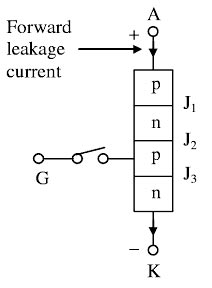In the forward blocking mode, the middle junction (J2) has the characteristics of that of a:
Right Answer is:
Capacitor
SOLUTION
A silicon controlled rectifier or semiconductor-controlled rectifier is a four-layer solid-state current-controlling unidirectional devices (i.e. can conduct current only in one direction).
The whole operation of the thyristor is divided into three modes:
- Forward blocking mode
- Forward conduction mode
- Reverse blocking mode
Forward Blocking Mode
The SCR is said to be forward biased when the anode is made positive with respect to the cathode. Due to this forward bias, the junction J1 and J3 are forward biased and J2 is reverse biased. Hence the forward voltage is to be held by junction J2. A very small current flows from anode to cathode. This current is called forward leakage current. This current is of the order of few milliamperes.
In case this voltage is increased to high values, then the reverse biased junction J2 will experience an avalanche breakdown at a particular voltage called forward breakover voltage, VBO. As a result, the thyristor switches to conduction (ON) state. When the forward voltage is less than VBO, SCR offers high impedance in forward blocking mode. When the forward voltage reaches VBO, the SCR turns on.

In forward blocking mode depletion layer J2 act as a dielectric and junction J1 and J3 acts as two plates. The SCR now behaves like a capacitor. Due to the space charges in the depletion region. The charging current of the capacitor is given as
I = C dv/ dt
where dv/dt is the rate of change of applied voltage and C is the junction capacitance.
When the switch is suddenly closed dv/dt is large. Large charging current C dv/ dt flows through the SCR and the junction J2 breaks down. Therefore the SCR turns on without a gate signal. This method is not generally used since large charging currents may damage the device.
